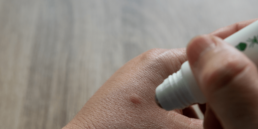HIVES
Hives, also known as urticaria, are a very common, noncontagious health problem. They are a skin reaction characterized by swollen, itchy red bumps or plaques.
Hives appear without warning and usually go away after a few hours. However, they may reappear elsewhere on the body. In some cases, the bumps will spread and join together, forming larger lesions known as plaques.
Hives are sometimes accompanied by a similar condition called angioedema, which affects deeper layers of the skin.
Angioedema has the following symptoms:
- Swelling of the face, eyelids, ears, mouth, throat, tongue, airways, hands, feet, and genitals
- Itchy, uncomfortable swelling
- Slightly red or normal-looking skin
CAUSES AND TRIGGERS
Hives are sometimes an allergic reaction, but they more often have a different trigger. They are generally categorized into one of three types depending on the cause.
Acute hives
Acute hives last anywhere from a few days to 1 or 2 weeks.
Potential triggers include the following:
- An infection due to a virus, bacteria, or parasite
- Medications such as antibiotics or anti-inflammatory drugs (e.g., aspirin, ibuprofen)
- A bug bite
- A food allergy
- Contact with latex or certain chemicals or plants
- Physical stress (e.g., exposure to light or heat) or
emotional stress - A health problem or autoimmune disease
It is not always possible to determine the cause of acute hives.
Chronic hives
Hives are said to be chronic if they last for more than 6 weeks. The condition is rarely permanent, and its symptoms vary widely. Individuals may experience episodes for months or even years, followed by periods of remission. The cause of chronic hives is often unknown. In some cases, they are linked to an autoimmune disease.
Inducible hives
A form of chronic hives, inducible hives have physical triggers that include the following:
- Exposure to the cold
- Perspiration or change in body temperature
- Vibrations (especially when driving)
- Pressure
- Physical exercise
- Water or daylight (rare)
TREATMENT
There are two parts to treating hives: avoiding triggers and taking medication to alleviate symptoms.
The following measures are recommended to relieve itching:
- Take a cold bath or shower
- Do not scratch the affected area
- Wear loose-fitting clothing
- Take antihistamines (e.g., Claritin)
Prescription medication may be used in certain cases. It may be necessary to administer epinephrine (EpiPen) if the reaction is severe or hampers breathing.
WHEN SHOULD I SEE A HEALTH CARE PROFESSIONAL?
Hives can sometimes develop into a more serious condition.
If you experience any of the following symptoms, consult your health care provider immediately:
- Signs of angioedema
- Wheezing or difficulty breathing
- Constriction of the throat
- Stomach pains
- Weakness or any other body-wide symptom
- Fever or chills
- Deeply coloured hives
- Dizziness or fainting spells
- Nausea or vomiting
- Hives that spread all over the body after an insect bite(sign of a severe allergic reaction)
It’s also recommended to see a health care professional if your symptoms last more than two days.
FOR MORE INFORMATION:
Allergy Asthma and Immunology Society Of Ontario
INSECT BITES
In addition to being unpleasant, insect bites can lead to a variety of health problems, some of which can be serious. In fact, the West Nile virus is transmitted by mosquitoes, and ticks transmit Lyme disease. Adequate protection is therefore important. Insect bites
PREVENTION
The best way to protect yourself is to avoid being bitten.
To reduce your risk, you can take steps to prevent bug bites, such as:
- Avoid products that contain fragrances, such as perfumes, and cover food when eating outside;
- Get rid of mosquito breeding sites by emptying standing water (e.g., remove water from pool cover, clean gutters regularly);
- Install screens on doors and windows;
- Avoid being outdoors at dusk and dawn when mosquitoes are most active;
- Wear long, light-coloured clothing. Mosquitoes are not as attracted to light-coloured clothing and they allow you to see ticks more easily;
- Tuck your shirt into your pants and pull your socks up over your pant legs;
- Wear a hat and closed shoes, avoid sandals;
- Wear clothing treated with the insecticide permethrin;
- Use insect repellent (bug spray).
INSECT REPELLENT (BUG SPRAY)
Repellents help reduce the risk of mosquito and tick bites but are not effective against bees, hornets and wasps.
Directions
- Read the entire label before applying;
- Spray in open, ventilated areas, well away from food. Do not spray in closed areas such as a tent;
- Apply the product lightly, just enough to cover clothing and exposed skin. Do not apply under clothing;
- Do not spray directly onto the face. Spray on hands first and then apply to the face;
- Avoid contact with the eyes. If spray gets into the eyes, rinse thoroughly with water;
- Do not apply on the child’s hands to avoid contact with the eyes and mouth;
- Do not use repellent on irritated or sunburnt skin or on an open wound;
- Repeat application only if necessary, according to the manufacturer’s recommendations;
- Wash the repellent off with soap and water as soon as protection is no longer required.
Choosing a repellent
There are many products available in Canada. Choice is based, among other things, on the person’s age, required duration of protection and product efficacy.
Products Duration of protection Minimum age
10% DEET 3 hours 6 months
20% DEET 5 hours 12 years
30% DEET 6 hours 12 years
10% ICARIDIN 5 hours 6 months
20% ICARIDIN 8 hours 6 months
Keep in mind that only DEET containing more than 20% and icaridin are considered effective against ticks. Also, the duration of protection is shorter for ticks than for mosquitoes.
Not recommended for protection
Certain products are not advised because there is insufficient evidence to support their efficacy, because of their short duration of action or because they may be harmful.
Here are a few examples:
- Electronic or ultrasonic devices
- Electrocuting devices (zappers)
- Wristbands, neckbands and ankle bands impregnated with repellents
- Odour-baited mosquitoes traps
- vitamin B1 taken orally
- Garlic
- Citronella geranium
- Products containing insect repellent combined with a skin moisturizer or a sun protection
TREATMENT
When you get an insect bite, here is what you can do:
- Apply ice or cold compresses to relieve any pain or inflammation.
- Take a pain reliever such as acetaminophen (e.g. Tylenol).
- Take an antihistamine by mouth to reduce inflammation and itching (e.g. Benadryl, Reactine).
- Apply an anesthetic such as benzocaine or pramoxine (e.g., Aveeno anti-itch) , calamine lotion or a cortisone derivative (e.g., hydrocortisone cream) to help reduce itching;
- If the insect has a stinger:
- remove the stinger as soon as possible to minimize any local reaction;
- wash the area with soap and water to prevent infection.
If a severe allergic reaction occurs, a dose of epinephrine (e.g., Epipen) may be necessary. If such a reaction does occur, get emergency treatment as soon as possible. Wearing a Medic Alert bracelet or carrying a card advising others that you are allergic to stings is also advised.
WHEN SHOULD I SEE A HEALTH CARE PROFESSIONAL?
Consult your health care professional if:
- you have a severe allergic reaction (anaphylaxis): see a healthcare professional immediately;
- you have a reaction that spreads over a wide area;
- you have a sting on the tongue or around the mouth;
- you have had a severe reaction to a sting;
- you have signs of infection (such as redness, heat, pus, fever);
- you notice that the treatment is ineffective after 7 days;
- you think you are having a reaction to an insect repellent.
FOR MORE INFORMATION:
Insect repellents – Government of Canada
Free delivery on prescriptions and medical supplies.
We offer free local delivery, curbside pick-up, and Canada wide shipping.

